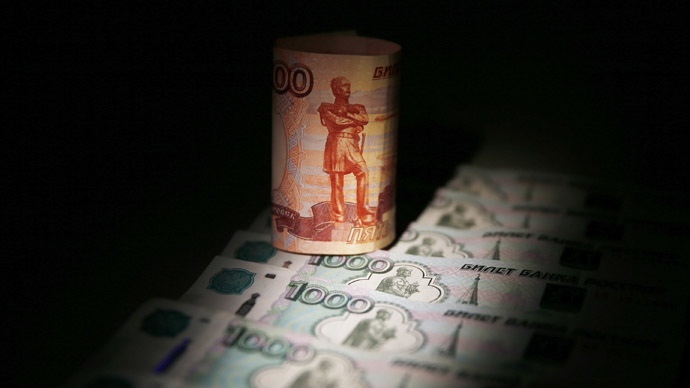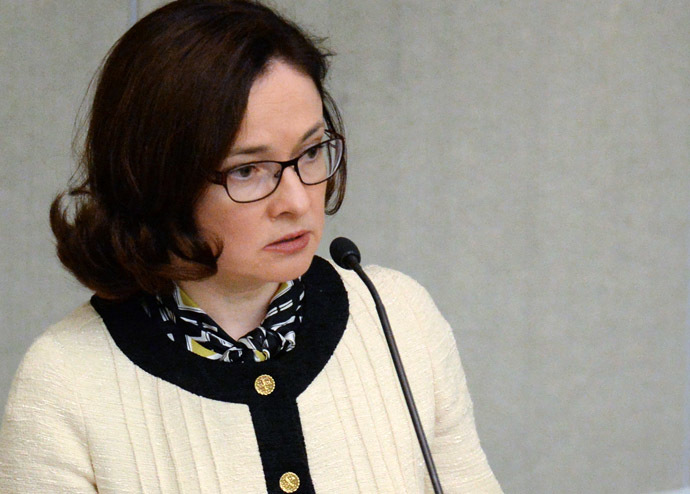Russia's next financial option may be 'nuclear'

The Russian Central Bank has seemingly lost control of the ruble, which lost more than 20% in just hours on Tuesday. Currency interventions and interest rates both have failed to save the ruble. The next major step could be limiting the cash flow.
After the Russian ruble fell to 1998 lows on Monday, the Central Bank met late into the evening and hiked the main lending rate to 17 percent to offset the tailspin ruble. It worked- for about four hours, then the ruble against nosedived against the dollar, euro, and sterling.
READ MORE: Ruble plummets losing more than 20% in a day, hitting new dollar and euro lows
On November 10, the bank introduced the ruble's free floating policy- which meant it would stop direct financial support, and would instead let the markets guide it. Before that, the Central Bank tried interventions, and after burning through $80 billion in foreign reserves, the ruble still went bust.
The markets took it to to new depths and lows. On Tuesday the euro nearly touched 100 rubles and the US dollar 80 rubles, both more than this time last year.
If interest rate hikes and interventions continue to have no sway on stabilizing the ruble, the Bank may be forced to enact more radical and less orthodox financial tools.
“The next option, and sort of the nuclear option in finance, is to impose capital controls. That would be any combination of withdrawal limits on the amount of money people can take from their bank accounts, transfer limits of how much people can convert into other currencies, and how much people can send abroad,” Yuval Weber, Associate Professor of Economics and International Affairs at the Higher School of Economics in Moscow, told RT.
So far, both the Central Bank and the Russian President have denied capital controls will be enforced.
Late night meeting
Tuesday's early 1:00am meeting was an attempt by the bank to keep money put in banks by raising interest levels to 17 percent. Last week it was increased to 10.5 percent, last January it was 5.5 percent, and during the 1988 crisis it was over 100 percent.
As a general macroeconomic principal, the higher the interest rates, the more likely people are to keep their money in the bank, and not want to pay for high interest loans. Higher interest rates can put a cap on inflation, but also stifle economic activity.
Russia is the only emerging market economy that lets currency flow freely across its borders. Russia abolished capital controls in 2006.
So far, the most radical action the bank has taken is actually not quite so radical: hiking interest rates.
“The Central Bank's policy of increasing baseline interest rates is a solid, orthodox decision,” Weber said.
However, the emergency interest rate failed to halt the ruble’s landslide tumble against hard currencies. The rate increase only calmed the ruble temporarily and the interventions
Flying money
Capital flight from Russia this year has been rampant, and in 2014 is expected to lose over US$120 billion, on par with the 2008 crisis. Previously, only about $50 billion on average left each year.
“There is an incredible amount of money leaving the country, known as capital flight, that is putting pressure on the exchange rates,” Weber said, pointing to the rush of savers switching their rubles for dollars, euro, and sterling.
It’s not just individuals that are running to the banks to switch to a safer currency, but big Russian businesses, as well.

“Why is the Russian Central Bank doing this? Because the Russian people have over 18 trillion rubles ($350 billion) in savings and the CBR is afraid people will start exchanging rubles in order to buy dollars,” Aleksandr Prosviryakov, a treasury and commodities consultant, told RT.
Speculative pressure has hit Russia as well as other emerging economies hard. The Central Bank said its decision to raise interest rates was to tackle exchange volatility.
“Russian companies need to buy dollars now in order to pay off foreign debts in December, this month we have to pay over $30 billion to foreign creditors. In January we don’t have much to pay in dollars, so the rate may stabilize,” Prosviryakov said.
In 2014, Russia has a total of $130 billion in foreign debt it must pay off. As it stands, the Central Bank has about $418 billion in foreign currency reserves, about $100 billion less than this time last year.












